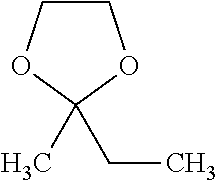Use of a ketal as a solvent in adhesives and ketal-containing adhesive composition
a technology of ketal and solvent, which is applied in the direction of adhesive additives, adhesive types, non-macromolecular adhesive additives, etc., can solve the problems of low solubility of ketal, low viscosity of adhesive compositions, and inability to provide compositions with high viscosity and appropriate drying time at levels similar to those of toluene-containing compositions, etc., to achieve high solubility and suitable drying time, the effect of high-
- Summary
- Abstract
- Description
- Claims
- Application Information
AI Technical Summary
Benefits of technology
Problems solved by technology
Method used
Image
Examples
example 1
[0027]A polychloroprene solution was prepared in 2-methyl-2-ethyl-1,3-dioxolane at a concentration of 2% by weight of the polymer, which was allowed to rest for 24 hours. After this period, in addition to the complete solubilization of the polymer, the formation of a gel was seen, conferring low flowability to the solution. Gel formation usually takes place by using toluene or an aromatic hydrocarbon solvent, and was not expected in the case of oxygenated solvents, such as 2-methyl-2-ethyl-1,3-dioxolane.
example 2
[0028]Polychloroprene solutions at 10 wt % were prepared in 2-methyl-2-ethyl-1,3-dioxolane and toluene, which were subjected to tests to study the time of solubilization of polychloroprene, the capacity for gel formation after solubilization, the viscosity of the solution and drying time to the touch after the formation of a film of the solution onto a surface. The solutions were stirred using a cowles-type disc at 150 rpm for a predetermined period of time and assays were carried out under the following conditions:
[0029]Room temperature=25° C.+ / −1° C.;
[0030]Hourly assessment of the solubility of the solutions;
[0031]Viscosity measurement by recording the temperature of the solutions, the ambient temperature and relative humidity;
[0032]Assessment of the drying time to the touch of the polychloroprene solution films formed onto the glass plate using a 150 micrometer extender;
[0033]Viscoelasticity analysis (Weissemberg effect);
[0034]Table 4 compares results obtained with both solutions...
PUM
| Property | Measurement | Unit |
|---|---|---|
| viscosity | aaaaa | aaaaa |
| total weight | aaaaa | aaaaa |
| thermal | aaaaa | aaaaa |
Abstract
Description
Claims
Application Information
 Login to View More
Login to View More - R&D
- Intellectual Property
- Life Sciences
- Materials
- Tech Scout
- Unparalleled Data Quality
- Higher Quality Content
- 60% Fewer Hallucinations
Browse by: Latest US Patents, China's latest patents, Technical Efficacy Thesaurus, Application Domain, Technology Topic, Popular Technical Reports.
© 2025 PatSnap. All rights reserved.Legal|Privacy policy|Modern Slavery Act Transparency Statement|Sitemap|About US| Contact US: help@patsnap.com

